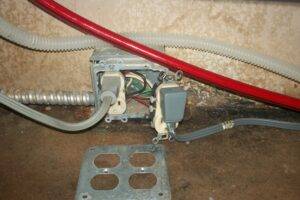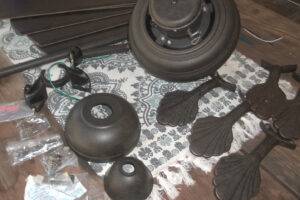The Edward's Enterprises team in Simi Valley install & repair bathroom exhaust fans consisting of:
-
Home bathroom exhaust fan repairs
-
Office bathroom fan installations
-
Bathroom ventilation fan replacements
-
Quiet exhaust fans installed
-
Exhaust fans ducted outside
-
Heater & fan combo fans installed
-
Exhaust fan switch installed
-
Bath fan & light combination install
-
Replace exhaust fan motors
-
Replace bathroom fan ducting
-
Increase air flow bath fan
-
Bathroom ventilation repairs
-
Assemble & install new fan
-
Install gable attic fans
Your existing bathroom exhaust fan may be loud, broken, or too small to really reduce the moisture in the bathroom & prevent damage & mildew. Your kitchen hood may be too loud, or you may only have a passive vent.
Bathroom ventilation fan repairs can be a DIY project, but can also be time consuming & complicated for many of our customers. In order to upgrade, install or repair the ceiling exhaust fan in your home or office bathroom, call our team now!
- Handy Tips
- Did You Know?
- Other Work
- DIY FAQs
Cleaning Exhaust fans is a chore that only needs to be done about twice a year. It can increase the flow of air dramatically & aid in venting steam & odors. A good cleaning can also prevent dust & dirt build up. Before you start cleaning, it is important to be aware of the safety warnings & precautions
First off, shut off the power to the unit before attempting to remove & clean it. Second, wear eye protection & gloves during this project. Third, if there are any major damages, seek professional help with repairs.
(Step 1) is to turn off the power to the exhaust fan. This will be located at the main circuit breaker.
(Step 2) is to use a drill or screwdriver to remove the screws that hold the exhaust fan's outer vented cover.
(Step 3) is to set aside the vent cover & locate the exhaust fan blade. Detach any additional screws that might be holding the actual fan in place & then slide the fan blade assembly out.
(Step 4) is to clean the vent cover. This can be done using a mild soap & water solution. Wipe away dirt & built up debris, & then dry it with a soft cloth.
(Step 5) is to use a small amount of window or mild kitchen cleaner to remove any unwanted mildew, dirt or debris from the fan blades. Make sure to clean both sides of the blades.
(Step 6) is to reinstall the unit, which can be done in the reverse order we used to dismantle the exhaust fan.
Requirements for Bathroom Exhaust Venting
Codes requiring a ventilation system in a bathroom have been in place for many years. Either a window or exhaust fan is required in all bathrooms, although both are optimum. Although they help rid the room of the detestable gases that is not the purpose of these exhaust systems. They are in place to eliminate the moisture preventing rot & mold from building up in the bathroom.
In order for an exhaust fan to do the job properly, it should be vented to the outside not just to the at
tic or between floors. Since there were no codes in place most builders just vent to the attic or between the 1st & 2nd floor, this would affect the integrity of the framing. During a remodel or building of a house, the electrician will wire the fan & the HVAC personnel is usually hired for heating & air conditionings not the exhaust system in the bathrooms.
Thanks for the Codes
As in the past with dryer vent codes were nonexistent, there are now mandates that a ventilation exhaust must be vented to the outside (these codes may or may not be applicable to all areas, ALWAYS contact your local building & safety department for guidelines in your home or business).
– R303 (Exception cont.) Ventilation air from the space shall be exhausted directly to the outside.
– M1501.1 Outdoor discharge. The air removed by every mechanical exhaust system shall be discharged to the outdoors.
– M1507.1 General. Where toilet rooms & bathrooms are mechanically ventilated, the ventilation equipment shall be installed in accordance with this section.
– M1507.2 Recirculation of air. Exhaust air from bathrooms & toilet rooms shall not be recirculated within a residence or to another dwelling unit & shall be exhausted directly to the outdoors.
Common sense is not always apparent
– R303.4.2 Exhaust openings. Exhaust air shall not be directed onto walkways.
– M1501.1 Air shall not be exhausted into an attic, soffit, ridge vent or crawl space.
– M1507.2 Exhaust air from bathrooms & toilet rooms shall not discharge into an attic, crawl space or other areas inside the building.
In Conclusion
Using the guidelines of the codes & common sense when purchasing & installing a ventilation system for the bathroom is the best approach. Will the moisture removal be adequate to prevent damage or mold to your home? If yes, then that is the best direction. Remember, these codes may or may not be applicable to all areas, ALWAYS contact your local building & safety department for guidelines in your home or business!
Where should a bathroom fan be installed?
How to position a bathroom vent fan
Your bathroom vent fan positioning will consist of two main issues; where the fan will serve you perfectly & where to run the ductwork effectively. For best results from your bathroom fan, ensure that you do the following;
1. Ensure where you place the bathroom fan is the area exposed to moisture, usually around the shower or bathtub.
2. Ensure you choose the shortest route to the roof or wall vent
3. Check the attic for enough room to make the transition from the fan to the duct.
4. Drill a locator hole
FAQ Source
Do bathroom exhaust fans need to be vented outside?
Tips on the installation of a bathroom exhaust fan
When you notice that your bathroom exhaust fan is noisy, then you should think of replacing it. You will have to make that trip to the hardware to get the necessary tools & materials to facilitate this process. The considerations will include the fan's size, the route of the exhaust fan, & the electrical options available. The process is simple; you have to remove the damaged exhaust fan, then you mount the new one with or without the attic access. If you feel uncomfortable doing the job yourself, hire an expert.
FAQ Source

 We charge for the time needed for a customer's project, including providing or delivering materials or for the time to haul away left over trash. This allows us to handle small jobs for our electrical clients, rather than only lump sum projects with much higher minimums to show up.
We charge for the time needed for a customer's project, including providing or delivering materials or for the time to haul away left over trash. This allows us to handle small jobs for our electrical clients, rather than only lump sum projects with much higher minimums to show up.




 Most electrical projects get a 3 hour window of arrival, so expect something like 7:00am to 10:00am, or 10:00am to 1:00pm, or even 12:00pm to 3:00pm window.
Most electrical projects get a 3 hour window of arrival, so expect something like 7:00am to 10:00am, or 10:00am to 1:00pm, or even 12:00pm to 3:00pm window.